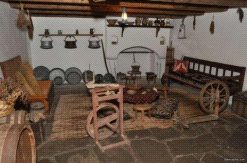

The Ethnographic House of Kavarna is open for visitors from 1984. It is located in a old Renaissance house restored and tansformed into a living museum of the town, of a middle-class family from the end of the XIX century. reveals everyday life of the main groups in this part of the Bulgarian population – the population of Dobrogea, Kotel, Gagauz. There are also presented some specific trades for that time – lace knitting and manufacture of slippers.
The ground floor was used as warehouses, basements and for various other needs. t can be seen an old slipper workshop, a small living room, which was for the newlyweds and old national clothing (Gagauz folk costumes from Kotel and from North Dobrogea).
Traces of human activity in the area dates back to the third millennium BC. The Greeks colonists from Mesemvria (today Nessebar) form in the area the Bizone colony in the V th cnetury BC. Today, at the Chirakman Cape, which is located 3 km south from Kavarna, w can find the remains of the city wall, built in sec. IV AD. n Antiquity and the Middle Ages the city is an important economic and cultural center. In XIVth century Karvuna (Kavarna) and the nearest town Kaliakra are the main cities of the Karvuna principality. After the fifteenth century, the medieval city Karvuna got the name Kavarna.
